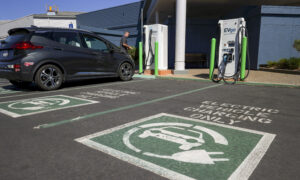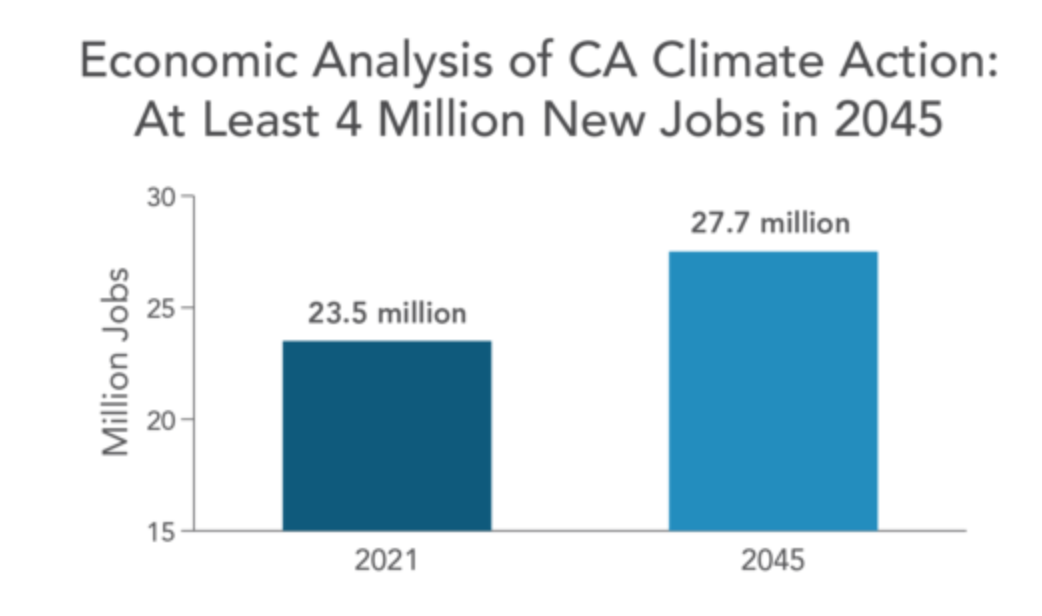The World Is Not Following California’s Climate Goals
CommentaryCalifornia’s climate goals might as well have been formulated in the Marvel Studios in Burbank. Consider, first, what’s really going on. The Financial Times reported Dec. 15: “Global coal use set to reach fresh record.” Subhead: “Growing demand and Ukraine war drive higher consumption despite promises on climate change to cut levels.” I’ve reported similar developments here in The Epoch Times, in particular China’s continued development of coal-powered energy. Next, consider the California Air Resources Board’s announcement the same day, Dec. 15: “CARB approves unprecedented climate action plan to shift world’s 4th largest economy from fossil fuels to clean and renewable energy.” Subhead: “Final 2022 Scoping Plan to reduce demand for petroleum by 94%, cut air pollution by 71%, reduce greenhouse gas emissions 85%, and reach carbon neutrality by 2045.” Check out this CARB chart: That’s Nitrous Oxide tons per day: NOx. In 2020, it was 1,300 for California. That comes to: 1,300 x 365 days = 474,500 tons of NOx per year. But consider this federal report from 1975: “Air Quality and Stationary Source Emission Control (1975),” Chapter 14, p. 763: California produced 1.833 million tons of NOx. That is, in 45 years, California reduced NOx from 1.833 million tons to 474,500, or by 74 percent. That was during a time the state population nearly doubled. Here’s the per capita reduction: 1975: 1.833 million metric tons of NOx/ population of 21.5 million = 0.085 metric tons per person. 2020: 474,500 metric tons of NOx/ population of 39.4 million = 0.012 metric tons per person. The drop then is from 0.085 metric tons of NOx per person to 0.012 metric tons per person. Or a drop of 85.9 percent in 45 years. Quite an achievement. Shouldn’t CARB at least acknowledge that vast improvement? I was in Los Angeles in 1978, two years after the federal report. I was in the U.S. Army studying Russian up in Monterey at the Defense Language Institute, and flew down to see my sister, who was in the U.S. Marine Corps stationed at El Toro. We drove around and saw the sights in Orange County and Los Angeles. I well remember how polluted and choking the air was. But it was familiar. In that federal report I linked to, I noticed California was only the third most polluted state. In second place was our native Michigan, at 2.5 million metric tons of NOx per year, due to the auto industry; and in first place was Pennsylvania, at 3.3 million tons, due to the steel industry. At the time in 1975, both Michigan and Pennsylvania had populations about half California’s—so double their numbers to compare them to California’s per capita levels. The point is the CARB report for 2022 should remind us how far we’ve come. And the questions arise: How clean can they get the air without shutting down the whole economy? How much progress is good, before the progress becomes so burdensome it turns negative? Of course, CARB’s goal isn’t just to clean the air in California, but to reduce CO2 globally and reduce “climate change.” Its new report insists: The California Air Resources Board today approved the final proposed 2022 Scoping Plan, a world-leading roadmap to address climate change that cuts greenhouse gas emissions by 85% and achieves carbon neutrality in 2045. The 2022 Scoping Plan provides a detailed sector-by-sector roadmap to guide the world’s fourth-largest economy away from its current dependance on petroleum and fossil gas to clean and renewable energy resources and zero-emission vehicles. … The availability of unprecedented state and federal investments will help propel this plan into ambitious action to address the existential crisis of climate change. The plan’s guidance will allow California to effectively and equitably build a better future for Californians through climate action. It remains amusing they keep referring to California as “the world’s fourth-largest economy,” when it’s really just a subset of the U.S. economy—which is going to be a good thing for this state. I’ve been reading Philip Zeihan’s recent book, “The End of the World Is Just the Beginning: Mapping the Collapse of Globalization.” I have disagreements in some areas. But one of numerous good points he makes is the globalized economy the United States imposed through its power after World War II, especially the U.S. Navy keeping the sea lanes open, now is ending. That will put an emphasis on continent-wide economies, of which the U.S. is the largest—a mostly self-contained entity, across the fruited plain and from sea to shining sea, including California. That means California will become more integrated into the U.S. economy, not less. Of course, California has clout nationally, including with the federal Environmental Protection Agency and Democrats in the U.S. Congress and the White House. So some of CARB’s policies will be applied there. But most will not. Texas isn’t going to ban oil production. But another effect of CARB’s rules will be to

Commentary
California’s climate goals might as well have been formulated in the Marvel Studios in Burbank. Consider, first, what’s really going on. The Financial Times reported Dec. 15: “Global coal use set to reach fresh record.” Subhead: “Growing demand and Ukraine war drive higher consumption despite promises on climate change to cut levels.” I’ve reported similar developments here in The Epoch Times, in particular China’s continued development of coal-powered energy.
Next, consider the California Air Resources Board’s announcement the same day, Dec. 15: “CARB approves unprecedented climate action plan to shift world’s 4th largest economy from fossil fuels to clean and renewable energy.” Subhead: “Final 2022 Scoping Plan to reduce demand for petroleum by 94%, cut air pollution by 71%, reduce greenhouse gas emissions 85%, and reach carbon neutrality by 2045.”
Check out this CARB chart:

That’s Nitrous Oxide tons per day: NOx. In 2020, it was 1,300 for California. That comes to: 1,300 x 365 days = 474,500 tons of NOx per year.
But consider this federal report from 1975: “Air Quality and Stationary Source Emission Control (1975),” Chapter 14, p. 763: California produced 1.833 million tons of NOx.
That is, in 45 years, California reduced NOx from 1.833 million tons to 474,500, or by 74 percent. That was during a time the state population nearly doubled. Here’s the per capita reduction:
1975: 1.833 million metric tons of NOx/ population of 21.5 million = 0.085 metric tons per person.
2020: 474,500 metric tons of NOx/ population of 39.4 million = 0.012 metric tons per person.
The drop then is from 0.085 metric tons of NOx per person to 0.012 metric tons per person. Or a drop of 85.9 percent in 45 years. Quite an achievement.
Shouldn’t CARB at least acknowledge that vast improvement? I was in Los Angeles in 1978, two years after the federal report. I was in the U.S. Army studying Russian up in Monterey at the Defense Language Institute, and flew down to see my sister, who was in the U.S. Marine Corps stationed at El Toro. We drove around and saw the sights in Orange County and Los Angeles. I well remember how polluted and choking the air was.
But it was familiar. In that federal report I linked to, I noticed California was only the third most polluted state. In second place was our native Michigan, at 2.5 million metric tons of NOx per year, due to the auto industry; and in first place was Pennsylvania, at 3.3 million tons, due to the steel industry. At the time in 1975, both Michigan and Pennsylvania had populations about half California’s—so double their numbers to compare them to California’s per capita levels.
The point is the CARB report for 2022 should remind us how far we’ve come. And the questions arise: How clean can they get the air without shutting down the whole economy? How much progress is good, before the progress becomes so burdensome it turns negative?
Of course, CARB’s goal isn’t just to clean the air in California, but to reduce CO2 globally and reduce “climate change.” Its new report insists:
The California Air Resources Board today approved the final proposed 2022 Scoping Plan, a world-leading roadmap to address climate change that cuts greenhouse gas emissions by 85% and achieves carbon neutrality in 2045. The 2022 Scoping Plan provides a detailed sector-by-sector roadmap to guide the world’s fourth-largest economy away from its current dependance on petroleum and fossil gas to clean and renewable energy resources and zero-emission vehicles. …
The availability of unprecedented state and federal investments will help propel this plan into ambitious action to address the existential crisis of climate change. The plan’s guidance will allow California to effectively and equitably build a better future for Californians through climate action.
It remains amusing they keep referring to California as “the world’s fourth-largest economy,” when it’s really just a subset of the U.S. economy—which is going to be a good thing for this state.
I’ve been reading Philip Zeihan’s recent book, “The End of the World Is Just the Beginning: Mapping the Collapse of Globalization.” I have disagreements in some areas. But one of numerous good points he makes is the globalized economy the United States imposed through its power after World War II, especially the U.S. Navy keeping the sea lanes open, now is ending. That will put an emphasis on continent-wide economies, of which the U.S. is the largest—a mostly self-contained entity, across the fruited plain and from sea to shining sea, including California.
That means California will become more integrated into the U.S. economy, not less. Of course, California has clout nationally, including with the federal Environmental Protection Agency and Democrats in the U.S. Congress and the White House. So some of CARB’s policies will be applied there. But most will not. Texas isn’t going to ban oil production.
But another effect of CARB’s rules will be to push even more people and industry out of this state, merely shifting the NOx to other locales.
CARB’s report also includes this graph:

That’s 23 years from now. Who knows what will happen by then? But CARB doesn’t include the number of jobs killed by its draconian new regulations.
Moreover, the state’s population now is shrinking by 0.3 percent per year. If that continues, by 2045 the state’s population would drop by 6.6 percent, or 2.6 million people. That’s nearly two-thirds of the “jobs” CARB says we’ll gain.
My point is none of these future numbers can be known—not CARB’s, not mine. I remember in 2009 demographers were saying the population might reach 70 million by 2050. It’s not going to happen. There’s an old saying: A trend is a trend until it bends.
What is happening for certain is CARB’s regulations will make California even more expensive to live in for the middle class, which will continue to leave. The state will become even more of a playground for multi-millionaires tooling around in their $200,000 electric luxury cars.
Views expressed in this article are the opinions of the author and do not necessarily reflect the views of The Epoch Times.












